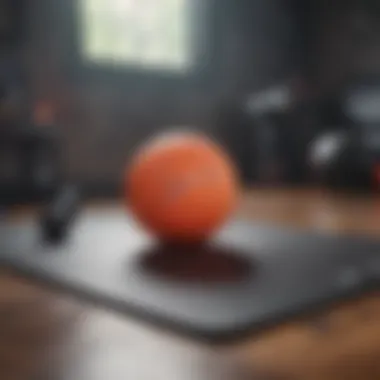Home Exercises for a Flatter Tummy: Effective Techniques


Intro
Achieving a flatter tummy is a common fitness goal for many individuals. While that perfectly sculpted midsection may seem like a far-off dream, it is attainable with the right approach. This journey is more than just a series of crunches and planks; it’s about integrating effective home exercises into a broader lifestyle strategy. Understanding the connection between exercise, nutrition, and daily habits can turn the pursuit of a toned abdomen into a manageable and fulfilling experience.
The importance of physical health cannot be overstated. A strong core not only enhances your appearance but also supports overall wellness. Practical exercises focus on not only the abdominal muscles but also on building endurance and stability, ensuring that those efforts translate into everyday physical activities. Moreover, many people overlook the mental benefits tied to regular exercise.
Engaging in physical activity can bolster confidence and reduce stress, leading many to find a more balanced state of mind. Let's delve into some key benefits of working towards a flatter tummy, covering both the physical and mental aspects that contribute to one's overall wellness journey.
Prelude to Home Workouts
When it comes to fitness, the idea of getting into shape can often feel daunting, especially when considering crowded gyms and unpredictable schedules. This is where the concept of home workouts springs to life, offering flexibility and accessibility like no other. Exercising at home gives you the freedom to create a personalized routine that fits your lifestyle, making it easier to maintain consistency. Not to mention, it saves the time one would otherwise spend commuting to and from a gym.
The Appeal of Exercising at Home
Exercising at home comes with its own set of perks that can often be overlooked. First off, the cost savings are significant. You’re not paying for a membership or special classes. Instead, you can invest in some basic equipment or even just rely on bodyweight exercises.
Moreover, the convenience factor cannot be stressed enough. Picture this: your workout gear is just steps away, no locker room hassles, no waiting for machines, and you can even squeeze in a few reps between household tasks. The comfort of home can make it easier to push through initially tough workouts, as you can do them in your cozy space at your own pace.
"Making time to work out at home can be a game changer, turning the toughest part of the day into something invigorating."
These factors lead to increased motivation, and when you have that intrinsic drive to work out, your chances of sticking to a regimen dramatically increase.
Setting Realistic Goals
A critical component of any successful fitness journey, whether at home or in a gym, is establishing clear, attainable goals. It’s easy to get swept up in daydreams of abs of steel or a size you’ve always wanted. However, aiming too high can lead to frustration or injury.
Instead, it’s vital to break down those lofty aspirations into bite-sized objectives. Start with what you can realistically manage, whether that’s committing to three home workout sessions a week or focusing on mastering a specific exercise, such as the plank or bicycle crunch. Here are some guiding ideas:
- Focus on form and technique rather than speed or numbers initially.
- Gradually increase your workout duration and intensity.
- Celebrate small victories, whether it’s adding extra reps or feeling stronger during a set.
By gradually working toward your end goals, you give yourself room for growth and adaptation, making the process not only effective but enjoyable.
Understanding Abdominal Anatomy
Understanding the anatomy of the abdominal area is foundational for effective home exercises aimed at achieving a flatter tummy. When we grasp how our body is structured, we can better understand which muscles to target and how to execute movements properly. This knowledge not only enhances workout effectiveness, but it also minimizes the risk of injury—after all, nobody wants to be sidelined by a tweak or a strain because of improper form.
In our daily life, our core muscles play a significant role in maintaining posture and supporting all types of movements. Therefore, a well-rounded comprehension of abdominal anatomy doesn’t merely inform our exercise choices; it dramatically informs our lifestyle choices as well, ensuring we engage our body in a way that is both efficient and safe.
Muscle Groups Involved
The abdominal region isn't just one homogenous mass. Rather, it consists of several muscle groups that each come into play during core-focused exercises:
- Rectus Abdominis: This is the well-known "six-pack" muscle, located at the front of the abdomen. It predominantly flexes the spine and is targeted during many traditional exercises like crunches.
- Obliques: These are situated on the sides of the abdomen and are crucial for twisting and bending movements. They play a key role in exercises such as Russian twists and side planks.
- Transverse Abdominis: This is the deep core muscle that acts like a natural weight belt, stabilizing the pelvis and spine. It engages in almost every abdominal exercise, ensuring the body maintains proper alignment and stability.
- Erector Spinae: While not part of the abdominal group per se, these muscles extend along the spine and help maintain posture; they often work synergistically with abdominal muscles during various exercises.
Understanding where these muscles lie and how they function can profoundly influence the way individuals design their workout routines. For instance, knowing that the transverse abdominis is pivotal for core stability may prompt one to incorporate more stabilization exercises.
"Strong abs not only look great but also provide the foundation for a strong body."
Role of Core Stability
Core stability is not just a fitness buzzword; it's a crucial aspect of any effective workout plan, particularly when aiming for a flatter tummy. Core stability refers to the ability to maintain the proper posture and alignment while engaging in various movements.
This stability involves not just the abdominal muscles, but also the muscles in the back, hips, and pelvis. When core stability is compromised, it can lead to poor form, which in turn can result in injuries or a lack of effectiveness in exercises. It’s like trying to build a house on a shaky foundation; eventually, things will crumble.
A strong, stable core enables:
- Efficient Movement: Helps in performing exercises more effectively, using proper mechanics.
- Injury Prevention: Reduces the risk of strains and ailments caused by mishandling certain movements.
- Enhanced Balance and Coordination: Improves performance in sports and daily activities by ensuring the body can work as a cohesive unit.
Incorporating exercises that specifically target core stability will bolster your overall strength and facilitate the journey toward achieving that flatter tummy you desire. These principles are essential not just in exercise, but also in daily activities, making understanding abdominal anatomy a key element of a healthier lifestyle.
Core Principles of Effective Workouts
Understanding the core principles of effective workouts is crucial for anyone seeking to achieve a flatter tummy. These principles not only lay the groundwork for a successful exercise regimen but also ensure that your efforts are safe and fruitful in the long run. Without proper knowledge and application, even the best intentions can falter, leaving one frustrated and without results.
Warm-Up and Preparation
Before diving into any workout, the importance of warming up cannot be overstated. Think of it as prepping a pot before cooking—without it, the meal may not turn out as desired. Warming up serves to gradually increase heart rate and blood flow to the muscles, making them more pliable and better prepared for the stress of exercise.


A simple warm-up can include dynamic stretches that engage the core muscles. For instance, performing torso twists and arm circles can help activate the muscles involved in tummy-tightening exercises. Other beneficial movements could be high knees or leg swings that not only encourage blood circulation but also prime your body for upcoming activity. A proper warm-up can reduce the risk of injury and set a positive tone for the workout that follows.
Here are some warm-up exercises to consider:
- Torso twists: Stand with feet shoulder-width apart, hands on your hips, and gently twist your upper body from side to side.
- Arm circles: Extend arms out to the side and move them in small circles, gradually increasing the size.
- High knees: Jog in place, bringing your knees up high towards your chest to engage your core.
Incorporating a cooling down period after workouts is also essential. This means taking a few minutes to gradually lower your heart rate and stretch out muscles used during the session. Cooling down prevents stiffness and aids in recovery—a crucial step that many overlook.
Breathing Techniques
Breathing might seem like a simple task, but proper techniques can significantly enhance the effectiveness of your workouts, especially when focusing on abdominal exercises. Getting it right means you'll engage the correct muscles and maximize your efforts.
One key breathing technique is known as diaphragmatic breathing, where the focus is on using the diaphragm rather than just the chest. This method not only aids in better oxygenation but also activates the core muscles more efficiently. While performing exercises like the plank or bicycle crunches, breathe in deeply through your nose, allowing your abdomen to expand and then exhale through your mouth, drawing your navel toward your spine.
"Effective breathing techniques enhance the connection between mind and body, enabling a more focused workout experience."
Additionally, utilizing a steady rhythm of inhaling and exhaling throughout your exercises can help maintain control and precision, preventing unnecessary strain on your body. The next time you approach your workout, pay attention to your breathing—it’s a game changer.
In summary, integrating a thoughtful warm-up, ensuring proper preparation, and mastering effective breathing techniques are not just recommendations; they are fundamental principles in crafting an effective workout regime. They help set the stage for success, making your journey towards a flatter tummy smoother and more achievable.
Key Exercises for a Flat Tummy
When it comes to achieving a flatter tummy, the right exercises play a pivotal role in enhancing abdominal musculature while reducing excess fat. Focusing on core workouts from the comfort of home not only saves time but fosters a consistent fitness routine tailored to individual needs. This section lays out a variety of effective exercises targeting the core, helping to build strength and endurance. Understanding their mechanics and benefits will enrich your fitness journey and keep you motivated.
Plank Variations
Plank variations are solid staples in any core workout, significantly contributing to the quest for a flat tummy. These exercises enhance both core strength and stability, which are crucial for overall fitness.
Standard Plank
The Standard Plank is a fundamental isometric exercise that primarily activates the rectus abdominis and transversus abdominis. This movement requires you to hold a position resembling the top of a push-up. The key characteristic of the Standard Plank is its ability to engage multiple muscle groups at once, promoting better overall core strength.
This exercise is widely regarded for its role in improving posture and stability. A unique feature of the Standard Plank is its adaptability; you can modify it to suit your fitness level. Beginners can start on their knees, while advanced practitioners can elevate their feet on a bench. However, maintaining proper form is vital since incorrect posture may cause strain on the back.
Side Plank
Shifting the focus, Side Planks emphasize the oblique muscles and the stabilizers along the sides of your core. By balancing on one arm and stacking your legs, you create tension throughout your midsection. The key characteristic of the Side Plank is its ability to target a different area of the core compared to the Standard Plank.
This exercise is beneficial for improving lateral strength and balance. A unique feature of the Side Plank is that it can be tailored by varying the angle of the supporting arm or elevating the top leg for added challenge. However, some may find this exercise challenging initially, so it’s important to practice consistent form to reap the full benefits.
Bicycle Crunches
Bicycle Crunches integrate a twisting motion, targeting the entire abdominal wall, especially the obliques. As you lie on your back and alternate bringing opposite elbows to knees in a pedaling motion, each repetition works to sculpt the tummy while improving coordination. The beauty of Bicycle Crunches lies in their ability to combine cardio with core strengthening, amplifying calorie burn during your workout. But it’s crucial to avoid pulling on the neck; instead, direct your focus on using the core muscles.
Leg Raises
Leg Raises are an exercise that isolates the lower abdominal muscles. As you lift your legs from a flat position, the movement engages the entire core, requiring stability and control. The key benefit of Leg Raises is their capacity to target the area below the belly button, which is often a struggle for many. A unique aspect is the ability to modify the movement to single-leg raises for varying intensity. To avoid back strain, it’s essential to keep the lower back pressed to the ground throughout the exercise.
Mountain Climbers
Mountain Climbers elevate the heart rate while simultaneously engaging the core. This dynamic aerobic exercise involves a sprinting motion from a plank position, making it an excellent full-body workout. They not only build core strength but also improve cardiovascular health and endurance. The demand for quick movement can lead to certain mistakes such as bouncing on the toes instead of driving the knees forward. Pay close attention to form, particularly core engagement, to maximize effectiveness and reduce risk.
Russian Twists
Russian Twists introduce rotational movement, targeting the obliques effectively. Sitting on the ground, leaning slightly back, and twisting your torso adds variety to traditional core training. One of the advantages of Russian Twists is their capacity to foster functional movement patterns beneficial for daily activities. However, improper form often leads to strain in the lower back; keeping the movements controlled is important. When performing, avoid rushing through the motion for the best results.
Creating a Balanced Routine
Creating an effective workout routine goes beyond just committing to daily exercises; it includes harmonizing various elements to cultivate a balanced and sustainable approach towards achieving a flatter tummy. This section illuminates the core facets of establishing a structured workout regimen, emphasizing both cardiovascular and strength training components. An even blend leads to optimal results, preventing monotony and ensuring that different muscle groups are engaged effectively.
Incorporating Cardiovascular Exercise
Cardiovascular exercise plays a crucial role in any fitness regimen, especially when targeting belly fat. It acts as a dynamic calorie burner, accelerating metabolism while aiding in overall weight loss. Think of activities like running, cycling, or even brisk walking—these not only spike your heart rate but also contribute to heart health.
- Frequency: Aiming for at least 150 minutes of moderate-intensity cardiovascular exercise weekly is a common guideline. This could break down into 30 minutes, five times a week. However, for more intense routines, you can adjust accordingly.
- Variety: The body craves diversity. Layering in different modalities—whether it's a cycling class one day followed by a swim the next—keeps the excitement alive and challenges your body from new angles.
- Intensity: The general rule is to keep your heart rate at a certain level to maximize fat burning. Utilizing intervals, such as alternating between high and low-intensity bursts, can enhance effectiveness and keep workouts fresh.
Engaging in cardiovascular workouts not only sheds calories but also enhances your stamina, making strength training more fruitful when it comes around.
Strength Training Essentials


Strength training is equally vital in the quest for a flatter tummy. More than just pumping iron, it builds muscle which, in turn, increases your resting metabolic rate. This increased metabolism aids in prolonged calorie burning, even when you're at rest.
- Incorporation of Core Exercises: Focus on effective movements that target multiple muscle groups. Squats, deadlifts, and push-ups are all excellent choices. They not only engage your core but also contribute to overall body strength.
- Consistent Routine: Ideally, you should include strength training sessions two to three times a week. Ensure your regimen is well-rounded, addressing all major muscle groups.
- Progressive Overload: To keep gaining strength, challenge yourself by gradually increasing weights or resistance. This keeps your muscles adapting and growing, which is essential for long-term results.
- Recovery: Don’t overlook recovery periods. Muscles grow during rest, so include rest days and light workout sessions to allow your body to heal, which ultimately supports continued development.
In summary, a balanced routine intertwines cardiovascular exercise and strength training. Each component contributes uniquely to your fitness journey, ensuring a comprehensive and effective approach to achieving fitness goals, emphasizing the flat tummy objective. By mixing things up, not only will results follow, but you’ll be less likely to hit a plateau or lose motivation.
Nutrition's Role in Achieving a Flat Tummy
When it comes to flattening the tummy, one cannot overlook the pivotal role of nutrition. While exercises like planks and mountain climbers lay the foundation, what goes on your plate is equally important. Good nutrition not only helps in shedding excess fat, but also provides the necessary fuel for workouts and recovery.
Over the years, many have learned the hard way that crunching away at their goals in the gym won't yield the desired results if they’re indulging in empty calories from sugary snacks or processed foods. Therefore, understanding how food influences body composition is crucial for anyone aiming for a flatter stomach.
Eating wholesome, nutrient-dense foods can significantly enhance your efforts. Foods rich in fiber, protein, and healthy fats support metabolic functions and digestion, which can minimize bloating and promote a leaner appearance. Also, managing portion sizes and being mindful of macronutrient ratios can aid in maintaining a healthy weight, helping you stay on track without feeling deprived.
"You can't out-exercise a bad diet" is a saying that rings true.
Foods to Emphasize
When constructing a meal plan geared toward achieving a flat tummy, certain foods tend to shine brighter than others. Here are some key categories you might consider:
- Lean Proteins: Chicken breast, turkey, fish, and legumes not only promote muscle repair but also help you feel full longer. Including rich sources of protein can also prevent unhealthy snacking.
- High-Fiber Foods: Foods such as whole grains, fruits, and vegetables aid digestion and support gut health. Fiber helps regulate bowel movements and keeps you feeling satisfied, reducing the temptation to overeat.
- Healthy Fats: Incorporating sources such as avocados, nuts, and olive oil can help curb cravings. Healthy fats are also essential for hormone regulation, which is vital for weight management.
- Probiotic-Rich Foods: Foods like yogurt and kefir, which promote healthy gut bacteria, can improve your digestive health. A balanced gut is crucial for nutrient absorption and can also help tackle bloating issues.
- Hydration: Although it's part of the hydration strategy discussed later, the consumption of water-rich foods like cucumber, lettuce, and watermelon can contribute to hydration and fullness.
Incorporating these foods consistently may lead to noticeable improvements not just in your tummy, but in overall vitality.
Hydration Strategies
While we often hear about the benefits of hydration, many overlook its importance when pursuing a flatter tummy. Staying adequately hydrated plays a significant role in digestion, nutrient absorption, and can even impact your workout performance.
Here are some practical hydration strategies:
- Regular Water Intake: Aim for at least 2 liters of water a day. Keeping a water bottle on hand can serve as a visual reminder to stay hydrated.
- Limit Sugary Drinks: Beverages with high sugar content can add empty calories and lead to weight gain. Instead, opt for herbal teas or infused water with fruits like lemon or mint for flavor.
- Consume Water-Rich Foods: As mentioned earlier, including fruits and vegetables high in water content can help meet your hydration needs while also providing essential nutrients.
- Listen to Your Body: Pay attention to your thirst signals. Sometimes feelings of hunger are simply your body asking for hydration.
Tracking Progress Effectively
To effectively reach any fitness goal, one must pay close attention to how progress is measured and tracked. This is especially true for achieving a flatter tummy, where subtle changes may not always be immediately visible. Measuring progress isn’t solely about counting down the pounds or visible changes; it’s about recognizing improvements in strength, endurance, and overall well-being.
Measuring Results
Quantifying results provides individuals with tangible proof of their efforts. This can include various parameters such as:
- Body Measurements: Regularly measure your waist, hips, and abdomen. This can help in noticing a gradual reduction in size even when the scale does not move.
- Fitness Levels: Keeping track of how many repetitions you can do or how long you can hold a plank is essential. Progress in these areas signifies improvement in core strength.
- Body Composition: If possible, use tools to evaluate body fat percentage and lean muscle mass. This is a more in-depth way to gauge fitness as it provides a clearer picture than weight alone.
Incorporating these measurements into a fitness journal, or even a digital tracker, can give one a clearer visual of their journey. By noting down improvements and obstacles, individuals are more likely to remain motivated.
Adjusting Workouts Over Time
As time passes and progress is tracked, alterations in workout routines may be necessary. Recognizing when a regimen becomes stagnant or when workouts feel less challenging is crucial for ongoing improvement. Here’s how to adapt:
- Increasing Intensity: If exercises are becoming too easy, add more repetitions, reduce rest time, or increase the weight used in strength exercises. For instance, if someone has been comfortable at 10 reps of a leg raise, pushing to 15 or adding ankle weights can enhance results.
- Variety in Routine: Mixing different workouts not only keeps things fresh but also challenges various muscles. Incorporating new exercises or variations can stimulate growth. For instance, switching from standard crunches to different ones like cable crunches can prevent plateauing.
- Listening to Your Body: Pain and excessive fatigue are signs to reassess. Sometimes, less is more, and focusing on form rather than quantity can lead to better outcomes. Consider integrating rest days or low-intensity workouts when needed.
Overall, tracking progress effectively involves a blend of quantifying results and adjusting workout routines as needed. By maintaining a keen eye on personal developments, one can not only appreciate the journey but also ensure that the path to a flatter tummy is sustainable and enjoyable.
Common Mistakes and Misconceptions
When embarking on the journey toward a flatter tummy, many individuals encounter various misunderstandings that can hinder progress. Recognizing these common mistakes and misconceptions is crucial for fostering effective workout habits and promoting overall health. Here, we will delve into two significant areas: the myth of spot reduction and the dangers of overtraining. Understanding these elements not only refines workouts but also enhances results and minimizes the risk of injury.
Spot Reduction Myths
One of the most pervasive myths in fitness circles is the idea that one can spot reduce fat. This belief suggests that by focusing exercises on a specific area, such as the abdomen, an individual can effectively lose fat targeted in that region. In reality, fat loss occurs throughout the body, not just in the parts being exercised.
Studies suggest that genetics plays a larger role in where one stores and loses fat. The body burns fat from all over rather than solely from an area being worked out. So, while bicycle crunches or leg raises can strengthen the abdominal muscles, they won't magically melt away the fat directly atop them.
To aid fat loss, a more holistic approach is needed. Engaging in a combination of cardiovascular exercise, strength training, and sound nutrition is key. This balanced strategy results in overall fat reduction that will gradually reveal the toned abs hidden beneath.
"The best way to target fat loss is with a consistent and comprehensive fitness regimen."
Overtraining and Its Risks
Another critical misconception is the belief that more is always better when it comes to workouts. Many individuals mistakenly think that excessive training will yield faster results. However, overtraining can lead to a myriad of problems, including injury, burnout, and hormonal imbalances.


Signs of overtraining include persistent fatigue, a drop in performance, and even disrupted sleep patterns. When the body does not have adequate time to recover, it struggles to repair itself, leading to declining performance over time.
To prevent overtraining, it is essential to incorporate rest days into workouts and listen to one's body. Adjustments may involve alternating intensity, varying workout types, or even consulting with fitness professionals to craft a program tailored specifically to one's needs.
Ultimately, understanding the perils of overtraining allows for a more thoughtful approach to workouts, where quality trumps quantity, and sustainable practices help in reaching long-term fitness goals.
Expert Tips for Enhanced Effectiveness
When it comes to trimming down the tummy region, having a strategy can make all the difference. The journey to achieving a flat stomach is not purely about doing endless sit-ups or crunches; it's about employing an array of methods that will amplify the results of your hard work. In this segment, we'll delve into expert tips that would help optimize home workouts and facilitate a tighter, leaner midsection.
Mind-Body Connection
The mind-body connection is often undermined in the realm of physical fitness, but it holds immense significance, especially during abdominal workouts. Focusing on your mind while performing exercises can enhance your results in several ways.
- Awareness: Paying attention to how your abdominal muscles contract during exercises like planks or bicycle crunches can deepen the engagement of those muscles. This mental focus allows for a better workout and instills correct form and technique.
- Breath Control: Understanding how to breathe properly stabilizes your core and maximizes muscle activation. When engaging in complex movements like mountain climbers, exhaling during the exertion phase can help maintain your focus and energy.
- Visualization: Picture the desired outcome as you workout. Visualizing a stronger, flatter tummy can be an effective motivational tool that helps overcome mental barriers and encourages perseverance.
"The body achieves what the mind believes."
Incorporating mindfulness techniques such as meditation could also sharpen this connection, allowing for improved discipline and connection during workouts.
Variations for Increased Difficulty
Once you feel comfortable with foundational movements, it's time to spice things up! Variations not only stave off boredom but also challenge the body in different ways, further enhancing your results.
- Plank Variations: Try incorporating the plank jack or plank with alternating shoulder taps to make the traditional plank a bit more challenging. This variation intensifies the workout while keeping your core engaged.
- Leg Raises with Hip Lift: Transform the basic leg raise into a more complex move by adding a hip lift at the top. This adjustment targets the lower abs more effectively.
- Russian Twists with a Weight: If you want to really feel the burn in your obliques, use a medicine ball or a dumbbell during your Russian twists. The added weight will amplify the exertion.
- Bicycle Crunches with a Twist: Instead of simply pedaling forward, hold at the peak of the crunch and twist your torso. This will engage your obliques and deepen the workout.
By gradually integrating these variations into your regimen, you can effectively enhance the intensity of your workouts, keeping the challenge fresh and stimulating muscle growth.
Remember, the aim is not just to work harder, but to work smarter. The combination of a strong mind-body connection and varied exercises will set you on the right path toward achieving that coveted flat tummy.
Integrating Exercises into Daily Routine
Integrating exercises into your daily routine can make all the difference in achieving a flatter tummy. It’s not just about dedicating specific time to workouts; it's about weaving movement into the fabric of your everyday life. When exercise feels like a natural part of your day, you're more likely to stick with it long term, lending itself to sustained results. Regular activity helps boost metabolism, aids digestion, and contributes to overall health, making it essential for anyone looking to fine-tune their abdominal area.
Morning Stretch and Workout
Starting your day with a morning stretch and workout can be incredibly beneficial. It primes your body for the day ahead and helps you shake off the lethargy of sleep. Imagine rolling out of bed and spending just 10 to 15 minutes engaging your core and awakening your muscles. Simple routines, such as cat-cow stretches, bird-dogs, or short bursts of light yoga, can improve flexibility and set a positive tone for your day. This early activity not only boosts your energy but also sends a signal to your body that movement is a priority.
- Cat-Cow Stretch: Good for spine mobility and warming up.
- Bird-Dog: Engages core and promotes balance.
- Plank: Engages multiple core muscles quickly.
By establishing a morning routine, you cultivate discipline and can seamlessly transition into your day. Studies show that those who prioritize morning stretches and light workouts often report better focus and mood throughout the day.
Incorporating Movement During Work
Incorporating movement during work hours is another key step in your journey towards a flatter tummy. With many people working at desks, it’s easy to fall into a sedentary trap. Consider scheduling short breaks every hour to stand, stretch, or even perform mini workouts. You might do a couple of desk push-ups, use a stability ball instead of a chair, or take brisk walks around the office.
Here are a few ideas to keep you moving at work:
- Take the Stairs: Whenever possible, choose stairs over elevators.
- Standing Desks: Utilize a standing desk to reduce sitting time.
- Walking Meetings: If you can, suggest walking meetings instead of sitting in a conference room.
"Movement is a medicine for creating change in a person's physical, emotional, and mental states." – Carol Welch
Integrating small changes like these can elevate your heart rate and engage your core without taking up much time at all. Through consistent incorporation of these activities, the goal of achieving a flaater tummy becomes more manageable. Remember, it’s not about perfection; it’s about consistency and making every bit of movement count.
Long-term Lifestyle Changes
Long-term lifestyle changes represent the bedrock of any endeavor aimed at achieving and maintaining a flat tummy. It’s easy to get pulled into the allure of quick fixes, but going for the gold means adopting an enduring approach that focuses on sustainable behaviors. These transformations aren’t just about aesthetics; they weave into the fabric of overall well-being and health.
Sustaining Results
Once the initial goal is reached, the real challenge begins: sustaining those results. Many individuals find themselves slipping back into old habits, often due to a lack of structured strategies. To truly keep that flat tummy, consider the following elements:
- Consistent Physical Activity: Regular workouts should remain a pivotal part of daily life. Skipping workouts here and there might seem trivial, but consistency builds a habit that becomes harder to break.
- Balanced Nutrition: Maintaining a nutritious diet does not mean deprivation. Deriving enjoyment from meals while focusing on whole, nutrient-dense foods fosters a sense of satisfaction that helps keep temptations at bay.
- Mindful Eating Practices: Pay attention to what you consume. This is not just about quantity; understanding flavors, textures, and even emotions tied to food can significantly alter eating habits.
One effective approach is to keep a food and exercise journal. This practice heightens awareness and makes it easier to identify patterns that might lead to unwanted weight gain.
"It’s not about being perfect. It’s about making progress."
Building a Support System
Having a solid support system can be a game changer in the quest for a flat tummy. Engaging with others who share similar goals can create a blueprint for accountability and encouragement. Here are some ways to establish this network:
- Workout Partners: Find a buddy to join you in your workouts. Whether it’s virtual or in-person, sweating it out alongside someone can keep motivation high, especially on those off days.
- Online Communities: Participating in forums or groups on platforms like Reddit or Facebook can provide a wealth of support and shared experiences. Engaging with people going through similar journeys can offer new insights and resources you may not have considered.
- Professional Guidance: Sometimes, the wisest choice is to enlist the help of fitness trainers, nutritionists, or wellness coaches. Their expertise can streamline your path toward sustainable results, preventing common pitfalls.
In essence, long-term changes require commitment and support but can yield fulfilling outcomes in both your physical appearance and overall health. Building habits that stand the test of time paves the way for a healthier lifestyle that nourishes not just the body, but also the mind.















